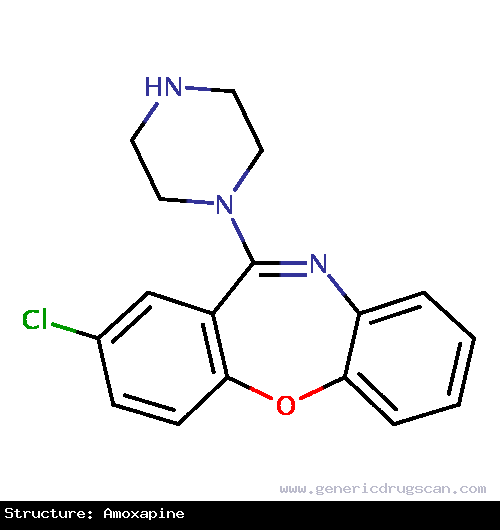Amoxapine Drug: Indication, Dosage, Precaution, Side Effect , Storage, Category Type and corresponding Brands - www.genericdrugscan.com
Amoxapine
Drug Status in USA : ApprovedDrug Status in Canada : Approved
pronunciation
pronounced as (a mox' a peen)
Why is this medication prescribed?
Amoxapine is used to treat depression. Amoxapine is in a class of medications called tricyclic antidepressants (TCAs). It works by increasing the amounts of certain natural substances in the brain that are needed to maintain mental balance.
How should this medicine be used?
Amoxapine comes as a tablet to take by mouth. It is usually taken one or more times a day. If you take amoxapine once a day, you should take it at bedtime. Try to take amoxapine at around the same time(s) every day. Follow the directions on your prescription label carefully, and ask your doctor or pharmacist to explain any part you do not understand. Take amoxapine exactly as directed. Do not take more or less of it or take it more often than prescribed by your doctor.
It may take several weeks or longer for you to feel the full effect of amoxapine. Continue to take amoxapine even if you feel well. Do not stop taking amoxapine without talking to your doctor. Your doctor probably will want to decrease your dose gradually.
What are the precautions to be followed?
Before taking amoxapine,- tell your doctor and pharmacist if you are allergic to amoxapine, doxepin (Sinequan), any other medications, or any of the inactive ingredients in amoxapine tablets. Ask your doctor or pharmacist for a list of the inactive ingredients.
- tell your doctor if you are taking a monoamine oxidase (MAO) inhibitor such as isocarboxazid (Marplan), phenelzine (Nardil), selegiline (Eldepryl, Emsam, Zelapar), and tranylcypromine (Parnate), or if you have stopped taking an MAO inhibitor within the past 14 days. Your doctor will probably tell you not to take amoxapine. If you stop taking amoxapine, you should wait at least 14 days before you start to take an MAO inhibitor.
- tell your doctor and pharmacist what prescription and nonprescription medications, vitamins, nutritional supplements, and herbal products you are taking or plan to take. Be sure to mention any of the following: anticoagulants (blood thinners) such as warfarin (Coumadin); antihistamines; cimetidine (Tagamet); flecainide (Tambocor); levodopa (Sinemet, Larodopa); lithium (Eskalith, Lithobid); medications for high blood pressure, seizures, Parkinson's disease, asthma, colds, or allergies; methylphenidate (Ritalin); muscle relaxants; propafenone (Rhythmol); quinidine; sedatives; selective serotonin reuptake inhibitors (SSRIs) such as citalopram (Celexa), escitalopram (Lexapro), fluoxetine (Prozac, Sarafem), fluvoxamine (Luvox), paroxetine (Paxil), and sertraline (Zoloft); sleeping pills; thyroid medications; and tranquilizers. Your doctor may need to change the doses of your medications or monitor you more carefully for side effects.
- tell your doctor if you are being treated with electroshock therapy (procedure in which small electric shocks are administered to the brain to treat certain mental illnesses) and if you have or have ever had a heart attack, glaucoma (an eye disease), an enlarged prostate (a male reproductive organ), difficulty urinating, seizures, an overactive thyroid gland, or liver, kidney, or heart disease.
- tell your doctor if you are pregnant, plan to become pregnant, or are breast-feeding. If you become pregnant while taking amoxapine, call your doctor immediately.
- if you are having surgery, including dental surgery, tell the doctor or dentist that you are taking amoxapine.
- you should know that this medication may make you drowsy. Do not drive a car or operate machinery until you know how this medication affects you.
- remember that alcohol can add to the drowsiness caused by this medication.
What are possible side effects of this medication ?
Amoxapine may cause side effects. Tell your doctor if any of the following symptoms are severe or do not go away:- nausea
- drowsiness
- weakness or tiredness
- nightmares
- dry mouth
- skin more sensitive to sunlight than usual
- changes in appetite or weight
- constipation
- difficulty urinating
- frequent urination
- blurred vision
- excessive sweating
- muscle stiffness
- confusion
- fast or irregular heartbeat
- slow or difficult speech
- shuffling walk
- uncontrollable shaking or moving of a part of the body
- fever
- rash
Amoxapine may cause other side effects. Call your doctor if you have any unusual problems while you are taking this medication.
How to store the medication and dispose it of after its use later?
Keep this medication in the container it came in, tightly closed, and out of reach of children. Store it at room temperature and away from excess heat and moisture (not in the bathroom). Throw away any medication that is outdated or no longer needed. Talk to your pharmacist about the proper disposal of your medication.
Drug Category/Class
- Antidepressive Agents, Second-Generation
- Serotonin Uptake Inhibitors
- Adrenergic alpha-1 Receptor Antagonists
- Dopamine Antagonists
- Neurotransmitter Uptake Inhibitors
- Antidepressants
- Non-Selective Monoamine Reuptake Inhibitors
- Antiemetics Antagonists
- Adrenergic Uptake Inhibitors
- Nervous System
- Psychoanaleptics
- CYP2D6 Inducers
- CYP2D6 Inducers (strong)
- Non-selective monoamine
| Prescribed | For the relief of symptoms of depression in patients with neurotic or reactive depressive disorders as well as endogenous and psychotic depressions... |
| Weight : | 313.781 |
| Structure | Amoxapine |
 | |
| Formula | C17H16ClN3O |
Amoxapine has 12 Brands listed
| A Pine (100 mg) | A Pine (50 mg) |
| Amolife (100 mg) | Amolife (50 mg) |
| Demolox (100 mg) | Demolox (50 mg) |
| Depilox (100 mg) | Depilox (50 mg) |
| Kamipox (100 mg) | Kamipox (50 mg) |
| Oxamine (100 mg) | Oxamine (50 mg) |
Search Generic Drugs alphabetically
